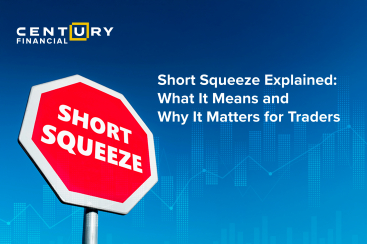Thursday, November 13, 2025
What Is Hedging in Risk Management? A Simple Guide for All Investors
By Century Financial in 'Blog'


Introduction to Hedging in Risk Management
In markets, risks and rewards go hand in hand. However, this doesn’t mean we have to take risks beyond our control when participating in markets. There are several risk management strategies that could help reduce your portfolio’s sensitivity to market volatility.
Hedging in risk management is one of those strategies; think of it as taking insurance for your investments. Hedging your portfolio can soften the impact of market swings on your portfolio. It can protect your investment against more than just market risk.
Here’s more about your portfolio savior:
What Does Hedging Mean in Investing?
Hedging refers to offsetting an existing exposure by taking a counter-position in a related asset. So, when the market moves in an unfavorable direction, your counter-position could continue to safeguard your portfolio.
Hedging and risk management focus on reducing the adverse effects of market movements on financial exposure. Options, futures, and forwards are commonly used to hedge portfolios. For example, you can buy a put option or sell a futures contract of a stock or index if you feel a market downturn. The net effect is reduced portfolio variance, which gives risk-adjusted returns.
Types of Financial Risks That Can Be Hedged

Market Risk
Market or systematic risk arises from broader movements in financial markets, which cannot be mitigated through diversification. Hence, for better risk management, you can use index futures, volatility futures, or options to take an opposing position from that of your portfolio.

Currency Risk
Currency or FX risk occurs due to changes in foreign exchange rates affecting cash flows and investments denominated in foreign currencies. Using FX forwards, swaps, and currency options to take counter-positions, individuals and institutions hedge to reduce currency risk.

Interest Rate Risk
Fixed-income products and bonds are particularly susceptible to this risk. Raising rates can lower the yield, thereby reducing returns for lenders. Interest rate swaps help dodge this risk and stabilize fixed income returns. Investors with bond-heavy portfolios can thus mitigate interest-rate risks through hedging.

Credit or Default Risk
Financial risk hedging doesn’t stop those created by pure market forces. Credit or default risk occurs when a counterparty or borrower fails to meet their obligations. Credit default swaps, for example, provide a payout in the event of a default by the reference entity, helping investors dodge default possibilities.
Popular Hedging Instruments

Options and Futures
Options and futures are among the most widely used instruments in hedging and risk management. Options are more flexible, and futures allow you to lock in prices ahead of time. Understanding how to trade in these instruments can give you flexibility and limited downside risk in some positions.

Inverse ETFs
Inverse ETFs are exchange-traded funds designed to move in the opposite direction of the index or assets they track. Here, you can protect against market downside without short selling, making it a great instrument for hedging. Investors who understand the trading basics use inverse ETFs to safeguard their portfolio.

Diversification
Diversification is the most timeless and universal form of risk management. Managing risk while trading is made easy through choosing instruments that belong to different sectors, classes, and risk levels. Though diversification doesn’t hedge against systemic risk, it does protect you against idiosyncratic exposures.

Stop-Loss Orders
Stop-loss orders are one of the simplest yet most effective hedging tools. Setting an order on a predetermined price will help you limit downside risk by offloading those assets when they reach a certain price. Hedging in risk management need not always be about adding to your positions.
How Hedging Works: Simple Examples
Imagine a UAE-based exporter expecting payments in USD. After studying some trading patterns, they feel the dirham strengthens against the dollar; their future income shrinks. So, to hedge, they use a futures contract to lock in the current exchange rate.
A small investor is sure that the market is on the verge of a correction. They are not interested in selling the securities in their portfolio. They go ahead and buy a put option. If the market takes a downturn, they might make up for their portfolio losses through gains from their put position.
Benefits and Limitations of Hedging
| Benefits | Limitations |
|---|---|
| Protects portfolio from downside risks | Comes with costs like premiums, fees, and margin |
| Provides stability during volatility | Can limit upside from original position too |
| Flexible because of multiple instruments | Strategies can be complex and difficult to implement |
| Helps manage multiple risks in one go | Can introduce new risks (leverage in F&O) |
| Can help build confidence | Not foolproof, extreme events can still cause losses |
For a smoother experience while hedging,
Tools & Platforms to Hedge Your Investments
Understanding volatility and managing risk can sound complex, but with the right tools, it can be easy and quick. With the Century Trader App, you will have access to all the necessary tools, including live charts, education hubs, and research insights, to make informed decisions. With stocks and CFDs and F&O available to traders through the trusted IBKR platform, Century ensures your trades are hedged smoothly.

Is Hedging Suitable for You?
Hedging is definitely not a one-size-fits-all strategy, but if you hold a position in the financial markets, financial risk hedging is for you. It is best suited for preserving capital, limiting downside risk, and bringing stability to long-term strategies. Even at additional costs, hedging can stop your portfolio from going deep into the red.
If you are someone who worries about markets or finds it hard to analyze them, it is advisable to learn a few of the hedging strategies and safeguard your portfolio against risks prevalent in the market.
Conclusion
In trading terminology, it will be hard to find a concept this critical in the markets that benefits both long- and short-term investors alike. Reducing risk and making the portfolio stronger in the face of market unpredictability gives it a unique allure.
But no matter what the strategy is, having a dependable platform and broker makes it stronger and more solid. With Century, you need to focus solely on your methods and portfolios because we ensure everything from order execution to settlement happens seamlessly.
FAQs
Q1. What is the purpose of hedging in financial risk management?
A: The primary purpose of hedging is to reduce exposure to adverse market movements, effectively acting like portfolio insurance.
Q2: Is hedging the same as diversification?
A: Diversification is a type of hedging in risk management. Hedging also extends to using tools like stop losses or F&O instruments to reduce risk.
Q3: Which tools are used for hedging market risk?
A: Common hedging instruments include options, futures, inverse ETFs, diversification, and stop-loss orders.
Q4. Can retail investors hedge their portfolios in the UAE?
A: Yes, retail investors in the UAE can hedge their portfolios through local and global financial market assets.
Q5. What are the risks of using hedging strategies?
A: Hedging and risk management might come with additional costs. Poorly executed strategies may even amplify risks.
The content in this blog, including any research, analysis, opinions, forecasts, or other information (collectively, "Information"), is provided by Century Financial Consultancy LLC (CFC) for marketing, educational, and general informational purposes only. It should not be construed as investment advice, a recommendation, or a solicitation to buy or sell any financial instruments.
This Information may also be published across various channels, including CFC’s website, third-party platforms, newsletters, marketing materials, emails, social media, messaging apps, webinars, and other communications. While CFC strives for accuracy, we do not guarantee the completeness, reliability, or timeliness of any content. Any decisions made based on this Information are at your own risk. CFC accepts no liability for any loss or damage arising from its use.
Trading financial products involves significant risk and may not be suitable for all investors. Please ensure you fully understand the risks and seek independent professional advice if necessary.
Please refer to the full risk disclosure mentioned on our website.









.png)
.png)
.png)
.png)


